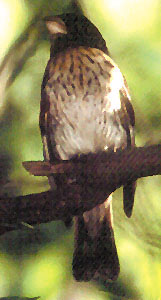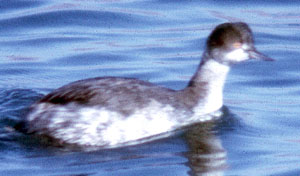

Albert Ghiorso photographed this grebe at Bodega Bay, California, 20 November 1971.
Jo Heindel photographed this odd looking grosbeak at Crane Creek, Ohio, 15 May 1998.
I'd like to thank all the contributors for this month's mysteries. Comments were excellent; please keep them coming!
The grosbeak is odd indeed, and seems to be outside the range of variation of immature male Rose-breasted Grosbeak. Grosbeaks in winter plumage often look quite different than in the spring, and many "immature" male grosbeaks reported in the winter are actually merely adults in winter plumage. But that doesn't seem to offer any help with this individual.
This bird is certainly a form of Rose-breasted Grosbeak, and from what I can see of the head, it appears to be a male. The breast pattern is typical of females and some juvenile males. Matt Heindel, who saw the bird in life, made the interesting suggestion that it might be a gynadromorph. My understanding of this type of plumage abnormality is that it is caused by an aberration in the first cell division and the resulting birds usually become male on one side and female on the other. Such cases have been reported in the Orchard Oriole, Black-throated Blue Warbler, Evening Grosbeak, American Kestrel and House Sparrow (Gill, F.B. Ornithology 1995). It is unknown in mammals in which hormones override the genetic differences between right and left sides.
The mystery bird is not that type of hermaphrodite but without an internal examination, I don't think there is any way to be sure what going on. One possibility is that the bird has somehow retained juvenile plumage on its underparts via partial delayed maturation. It would be helpful to see the wing pattern on this bird. A check of the extent of white on the bases of the primaries and the condition of the primary feathers might help determine the age of this bird.
For more general information on grosbeak identification, I have a text version of a paper which I published in Birding available online here.
Those who guessed that the mystery grebe was an Eared were correct. I had an ulterior motive in publishing this picture. My intent was to debunk a published field mark which I regard as totally unreliable. This bird clearly shows a white lore spot, supposedly diagnostic for Horned Grebe according to the National Geographic Guide. At least one otherwise excellent identification paper (Western Tanager, May 1985) emphasizes this character. It is true that Horned Grebes show this mark, but some Eared Grebes, such as this one show this mark as well.
Thanks again for the good comments.
The original images are below:
|
|
Albert Ghiorso photographed this grebe at Bodega Bay, California, 20 November 1971. Jo Heindel photographed this odd looking grosbeak at Crane Creek, Ohio, 15 May 1998. |
What do you think these birds are? Please click here to view comments or add your own. Thank you very much for contributing your thoughts.